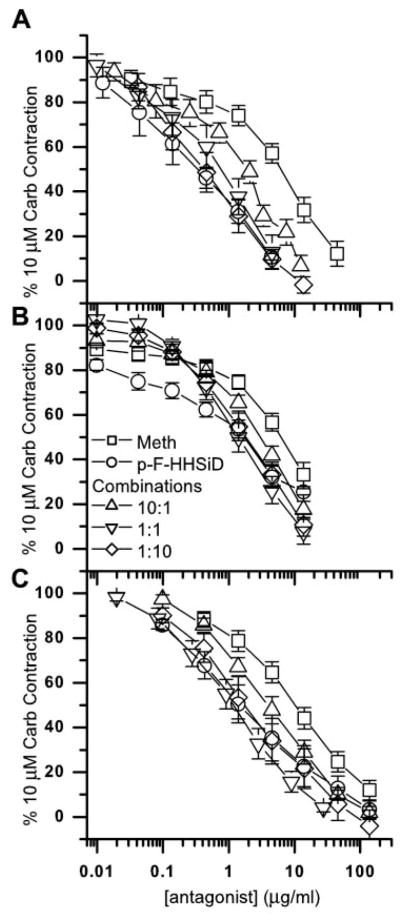Fig. 1.
Inhibition of carbachol (Carb; 10 μM)-induced contraction of normal (A), denervated (B), and thapsigargin-treated rat urinary bladder muscle strips (C) in the presence of methoctramine (Meth; □), para-fluoro-hexahydro-sila-diphenidol (p-F-HHSiD; ○), and methoctramine:p-F-HHSiD wt/wt combinations [10:1 (△), 1:1 (▽), and 1:10 (◇)]. Data are presented as means ± SE of 6–10 muscle strips from at least 4 different animals per condition. A: normal. Hill slopes: 1.06 ± 0.09 (methoctramine), 0.76 ± 0.08* (p-F-HHSiD), 1.09 ± 0.03 (10:1 combination), 0.93 ± 0.09 (1:1 combination), and 0.76 ± 0.06* (1:10 combination). B: denervated. Hill slopes: 0.65 ± 0.08* (methoctramine), 0.64 ± 0.05* (p-F-HHSiD), 0.96 ± 0.07 (10:1 combination), 1.00 ± 0.04 (1:1 combination), and 0.88 ± 0.04* (1:10 combination). C: thapsigargin treated. Hill slopes: 0.82 ± 0.09 (methoctramine), 0.70 ± 0.07* (p-F-HHSiD), 0.79 ± 0.03 (10:1 combination), 0.96 ± 0.07 (1:1 combination), and 0.81 ± 0.06* (1:10 combination). *Hill slope significantly different from 1.0 (P < 0.05).

